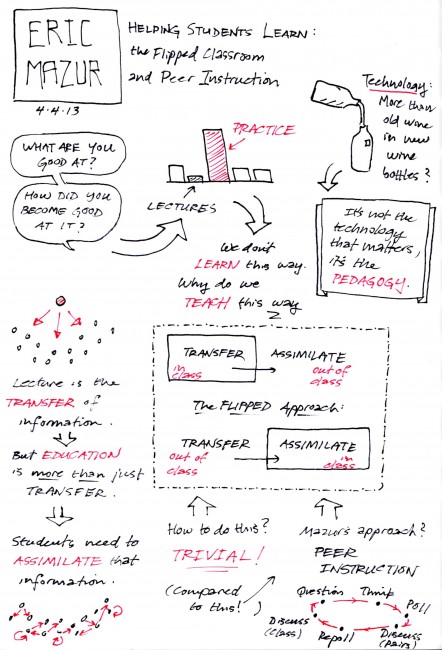Using Peer Instruction to Flip Your Classroom: Highlights from Eric Mazur’s Recent Visit
by CFT Director Derek Bruff
 On April 4th, during his talk at the School of Medicine, Harvard physics professor Eric Mazur polled an audience of Vanderbilt faculty, staff, and students, asking us how we learned what we need to know for our jobs. Very, very few of us said that we learned those skills from lectures, prompting Mazur to say, “We don’t learn this way. Why do we teach this way?”
On April 4th, during his talk at the School of Medicine, Harvard physics professor Eric Mazur polled an audience of Vanderbilt faculty, staff, and students, asking us how we learned what we need to know for our jobs. Very, very few of us said that we learned those skills from lectures, prompting Mazur to say, “We don’t learn this way. Why do we teach this way?”
Mazur was on campus to deliver this year’s John E. Chapman Lecture in Medical Education, co-sponsored by the Dean’s Lecture Series and Medical Education Grand Rounds at the School of Medicine. However, “lecture” is not the best way to describe what Mazur did in Light Hall 208 that day. As we walked into the venue, we were handed little radio-frequency devices (“clickers”) that allowed those present to respond to multiple-choice questions posed by Mazur. Mazur’s clicker questions and the small-group discussions they structured turned the event into a highly interactive one, with participants experiencing–not merely hearing about–many of the ideas Mazur shared with us.
There is great interest in higher education today in what is often called the “flipped classroom.” This idea isn’t a new one. Mazur started flipping his physics classrooms two decades ago by asking his students to read their textbooks before class and structuring his class sessions around small-group discussions of interesting and important physics questions. During his session last week, Mazur described lecture as the transfer of information and argued that education is more than just transfer–it also requires students to assimilate that information in ways that help them solve problems. His opening clicker question, asking us to reflect on how we learned important skills, supported his argument: the most common response was “practice,” not “lecture.”
Mazur described traditional college teaching, especially science teaching, as follows: information is transferred from instructor to student during class, and students work to assimilate that information after class through homework and problem sets. The flipped approach shifts that second step–the assimilation step, which Mazur argues is a much more challenging step for students–to the class session, where the instructor and other students can assist more readily in the learning process. To make that possible, the transfer step is shifted before class, with students encountering information they will need during class through readings or videos. See my sketchnotes below for a diagram of this “flip”:
What kinds of pre-class experiences should students have as part of the flipped classroom? Given all the energy at Vanderbilt and elsewhere around the production of online videos for this purpose, I found Mazur’s answer to this question rather provocative: Designing the pre-class portion of the flipped classroom is trivial. That is, the decisions you make about the “transfer” step that happens outside of class are trivial compared to the decisions you make about the in-class “assimilation” step.
I think Mazur was being intentionally hyperbolic when he called the design of pre-class activities “trivial,” but his point is a sound one. Spending all one’s effort designing the out-of-class component of a flipped classroom misses the point: What happens during class is far more important than what happens before class. Shifting the transfer step out of the classroom frees time during class to help students with the assimilation step. Designing in-class learning experiences that do so? That’s the non-trivial part of a flipped classroom.
Mazur spent the second half of his presentation walking us through a bit of what he does with students during class. Mazur coined the term “peer instruction” to describe his typical in-class activity. Here’s a summary from our teaching guide on clickers:
The teacher poses a question to his or her students. The students ponder the question silently and transmit their individual answers using the clickers. The teacher checks the histogram of student responses. If significant numbers of students choose the wrong answer, the teacher instructs the students to discuss the question with their neighbor. After a few minutes of discussion, the students submit their answers again. This technique often (but not always!) results in more students choosing the correct answer as a result of the peer instruction phase of the activity. This is a fairly simple way to use clickers to engage a large number of students in discussions about course material. This approach can also set the stage for a class-wide discussion that more fully engages all students.
In the spirit of active learning, instead of telling us about this process, Mazur had us participate in it, tackling a heat transfer question from one of Mazur’s physics courses. I’ll attest that a room full of Vanderbilt faculty, staff, and students discussing a tough physics question creates quite a commotion!
Although it’s not the same as being there, video from Mazur’s presentation on April 4th is available to anyone with a VUnet ID. If you aren’t affiliated with Vanderbilt, you can watch his “Confessions of a Converted Lecturer” talk on YouTube, which tackles similar topics. You can also read our teaching guide on the flipped classroom, recently authored by CFT assistant director Cynthia Brame. And if you’re a member of the Vanderbilt community, you’re invited to speak with one of our teaching consultants about flipping your own classrooms. Just give us a call (322-7290) to set up a consultation.
Thanks to Eric Mazur for an engaging and inspiring presentation, and thanks to our colleagues at the School of Medicine for hosting him!


Leave a Response